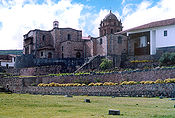
Coricancha
Encyclopedia

Inti
According to the Inca mythology, Inti is the sun god, as well a patron deity of the Inca Empire. His exact origin is not known. The most common story says he is the son of Viracocha, the god of civilization.- Worship :...
Kancha (' Temple of the Sun') was the most important temple in the Inca Empire
Inca Empire
The Inca Empire, or Inka Empire , was the largest empire in pre-Columbian America. The administrative, political and military center of the empire was located in Cusco in modern-day Peru. The Inca civilization arose from the highlands of Peru sometime in the early 13th century...
, dedicated primarily to Inti
Inti
According to the Inca mythology, Inti is the sun god, as well a patron deity of the Inca Empire. His exact origin is not known. The most common story says he is the son of Viracocha, the god of civilization.- Worship :...
, the Sun God. It was one of the most revered temples of the capital city of Cusco
Cusco
Cusco , often spelled Cuzco , is a city in southeastern Peru, near the Urubamba Valley of the Andes mountain range. It is the capital of the Cusco Region as well as the Cuzco Province. In 2007, the city had a population of 358,935 which was triple the figure of 20 years ago...
.
The walls and floors were once covered in sheets of solid gold
Gold
Gold is a chemical element with the symbol Au and an atomic number of 79. Gold is a dense, soft, shiny, malleable and ductile metal. Pure gold has a bright yellow color and luster traditionally considered attractive, which it maintains without oxidizing in air or water. Chemically, gold is a...
, and the courtyard was filled with golden statues. Spanish
Spain
Spain , officially the Kingdom of Spain languages]] under the European Charter for Regional or Minority Languages. In each of these, Spain's official name is as follows:;;;;;;), is a country and member state of the European Union located in southwestern Europe on the Iberian Peninsula...
reports tell of its opulence that was "fabulous beyond belief". When the Spanish required the Inca to raise a ransom in gold for the life of the leader Atahualpa
Atahualpa
Atahualpa, Atahuallpa, Atabalipa, or Atawallpa , was the last Sapa Inca or sovereign emperor of the Tahuantinsuyu, or the Inca Empire, prior to the Spanish conquest of Peru...
, most of the gold was collected from Coricancha.
The Spanish colonists built the Church of Santo Domingo on the site, demolishing the temple and using its foundations for the cathedral. Construction took most of a century. This is one of numerous sites where the Spanish incorporated Inca stonework into the structure of a colonial building. Major earthquakes have severely damaged the church, but the Inca stone walls, built out of huge, tightly-interlocking blocks of stone, still stand due to their sophisticated stone masonry. Nearby is an underground archaeological museum, which contains numerous interesting pieces, including mummies, textiles and sacred idols from the site.

